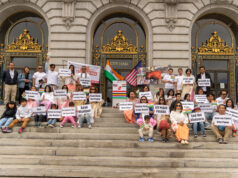Soram Idiyasan Chanu who is currently pursuing PhD in Delhi University, South Campus under Dr. Surajit Sarkar. The team led by Dr. Surajit Sarkar has been able to identify the target gene which can stop progression of Alzheimer’s, Parkinson’s through Cancer drugs.
She completed her graduation in B.Sc (Hons) Zoology from Daulat Ram College under the University of Delhi securing the first position from her college. Later, she did her Masters in Genetics from University of Delhi, South Campus and qualified for CSIR JRF. She started pursuing Ph.D in Genetics under the guidance of Dr. Surajit Sarkar, University of Delhi, South Campus in 2011 and has published many articles in International journals like Molecular Neurobiology, Cell & Developmental Biology, International Journal of Neurology Research etc.
She is the daughter of Soram Tomba Singh and Soram Inakhunbi Devi of Poiroukhongjin, Yairipok. Her father is a retired government employee from the department of agriculture. She completed her schooling from JNV, Kakching.
The original article was published in Molecular Neurobiology under Springer publications on Mar 21, 2016. The link is provided below: http://link.springer.com/article/10.1007/s12035-016-9858-6.
“Our study demonstrates for the first time that a common drug target c-myc proto-oncogene can be used to treat two most devastating human disorders — cancer, and Alzheimer’s and Parkinson’s diseases,” Dr. Sarkar (Research Guide) said in an interview with The Hindu,
Manipurtimes briefly interacted with Soram Idiyasan Chanu.
Q1. What was your aspiration to undergo scientific research in Genetics area?
Ans: The study of genetics fascinates me as it has tremendous practical applications in life. The basic physical and functional unit of heredity is “gene” which is made up of DNA. A clear understanding of the genome of an organism can have important medical and social impacts like discovery of new therapies for genetic diseases.
Q2. How long do you usually spend in your laboratory and how do you keep your social engagement apart from research work?
Ans: I usually spend 10-12 hours every day in the lab Mon through Sat. I catch up with my friends and go for shopping on Sundays.
Q3. What is your dream and future plans of research
Ans: I would like to continue further research in the area of medical neurobiology and contribute towards the mankind’s well-being.
Q4. As a school student, what was your favorite subjects and what make you interested to study more in the area you are interested?
Ans: During my schooldays, I found interest in Mathematics, Biology and Chemistry. However, I have decided to continue my career in life sciences as I believe that it impacts lives of so many people directly.
Q5. What are your favorite foods and hobbies?
Ans: I love all Manipuri dishes and also love to experiment new cuisines every now and then. I enjoy watching movies and also reading novels.
Q6. What is your message to those who want to pursue scientific research as career choice
Ans: I would like to encourage young minds to pursue scientific research as this would only result in more scientific discoveries and inventions which would ultimately lead to the improvement of the society. However, one has to be careful in choosing this as a career choice because it’s a very long never ending journey where the fruits of success come at a very later stage in life.
Abstract of the article: Human tauopathies such as Alzheimer’s Disease (AD), frontotemporal dementia with parkinsonism linked to chromosome 17 (FTDP-17), Pick’s disease etc., are a group of neurodegenerative diseases which are characterized by abnormal hyperphosphorylation of tau that leads to formation of neurofibrillary tangles. Recapitulating several features of human neurodegenerative disorders, theDrosophila tauopathy model displays compromised lifespan, locomotor function impairment, and brain vacuolization in adult brain which is progressive and age dependent. Here, we demonstrate that tissue-specific downregulation of the Drosophila homolog of human c-myc proto-oncogene (dMyc) suppresses tau-mediated morphological and functional deficits by reducing abnormal tau hyperphosphorylation and restoring the heterochromatin loss. Our studies show for the first time that the inherent chromatin remodeling ability of myc proto-oncogenes could be exploited to limit the pathogenesis of human neuronal tauopathies in the Drosophila disease model. Interestingly, recent reports on successful uses of some anti-cancer drugs against Alzheimer’s and Parkinson’s diseases in clinical trials and animal models strongly support our findings and proposed possibility.













Two thumbs up Sis!
Two thumbs up Sis !
che idyason , congratulation !!
Congratulations !!! we are proud of you ,,,
Der u r d future of Manipur keep up we r wit u
ইচানগী নুংঙাইবা পাওসে ঐখোয় মনিপুরগী মিংনি য়ামনা নংঙাই কংলৈপাক ইমানা য়াইফারে 1
Congratulations Sis Proud of You
Great, keep it up.
Great to know abt this.
Idiyasan, wish you all the best
Yai2 Meitei chanura se
A great research under Sir Surajit Sarkar.
A great research under Sir Surajit Sarkar. Proud to be a Manipuri and MHGians – BHU.
A great research under Sir Surajit Sarkar. Proud to be a Manipuri and MHGians (BHU).
may I know the journal name …..?
Molecular Neurobiology under Springer Publications
The Institute name may be mentioned ? ICGEB at JNU campus !!!
It is not — It is Department of Genetics, University of Delhi South Campus, Benito Juarez Road, Dhaula Kuan, New Delhi
K